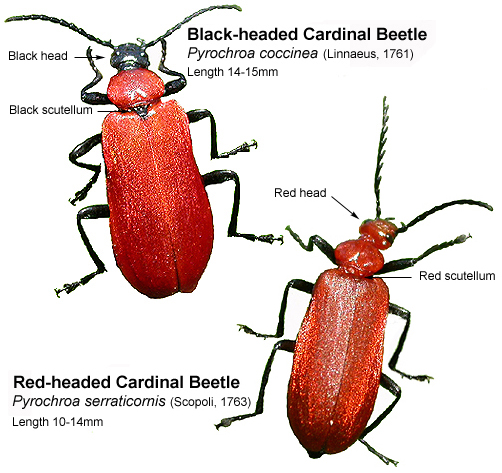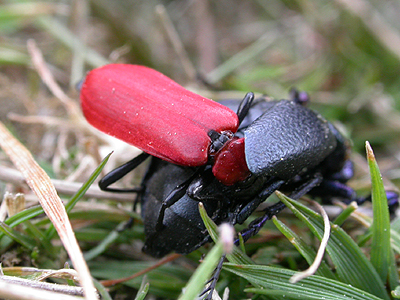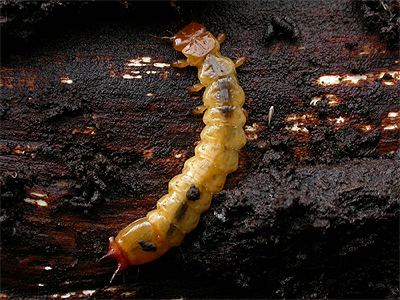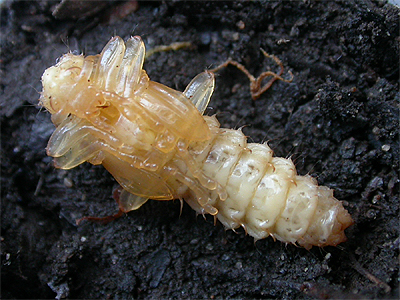

| Cardinal Beetles in Nottinghamshire | ||
| The superb colouration of much of
our native coleoptera, is well to many naturalists.
Perhaps the most well known of all, would be some of our
most common beetles such as Ladybirds - beetles which
everyone will know. But Nottinghamshire is home to two, large and bright red beetles - often commonly referred to as Red-headed and Black-headed Cardinal Beetles. Cardinal Beetles were very probably named after the red cassocks worn by Catholic Cardinals and they are both very distinctive beetles. The UK has three species of Cardinal Beetle contained within the family Pyrochroidae, but only the two Pyrochroa species are found in Nottinghamshire. The Scarce Cardinal Beetle (Schizotus pectinicornis) is rare and found only in parts of Wales and Scotland.
|
 |
|
| ...... | ||
 |
There is little chance of
misidentification with a few other equally red species,
due to size, overall shape and (in Nottinghamshire to a
large degree) location. Nottinghamshire has three red Click Beetles (Elateridae) and two Net-winged Beetles (Lycidae) that are similarly coloured and could pose problems for the inexperienced, but all are smaller and largely confined to the Sherwood Forest Country Park. Away from the Sherwood Forest and Clumber Park areas, identification is less of a problem. Life history Both species are carnivorous in the larval and adult stages, feeding on other invertebrates. On one occasion, we recorded a Pyrochroa coccinea adult feeding on the dead bodies of Oil Beetles (Meloe proscarabaeus) at Budby South Forest. |
|
| ...... | ||
| Once mated, eggs are laid by the female into suitable cracks and crevices of logs and the bark of dead trees. The larvae of both species live under loose bark or within rotting wood. They are very often found in the larval stage, by peeling the bark off fallen logs in suitable habitat - a practice that will often reveal them in various stages of growth. Pupation takes place under bark. | ||
| ...... | ||
 |
 |
|
| ...... | ||
| INSECTA (Class) - COLEOPTERA (Order) - PYROCHROIDAE (Family) - Pyrochroa (Genus) | ||
| Red-headed
Cardinal Beetle Pyrochroa
serraticornis (Scopoli, 1763) |
||
| Description:
Sometimes also referred to as the Common
Cardinal Beetle. Size ranges from 10mm to 14mm. Both
sexes are identical, although females tend to be slightly
larger. All the legs and antennae are black, as is the
underside. Viewed from the side and above, the head,
pronotum and elytra are a bright, slightly coppery red.
The similar Pyrochroa coccinea is a much more
vividly coloured red. When to see: Often be found on low vegetation growing along woodland rides and woodland edges. Adult beetles may be found under bark from early March, but generally start to appear on the first warm days of April and can be found throughout May, continuing to the end of June. Nottinghamshire distribution: The more common of the two Pyrochroas found in Nottinghamshire. Seems to prefer damper soils and habitats, so often occurs along the Trent Valley. There are few records from sites lying east of the River Trent, which is probably down to recorder effort, rather than being genuinely scarce. However, it has always been the rarer of the two species at sites lying on Sherwood Sandstone and within the Sherwood Forest NNR. |
||
| ...... |
|
|
|||||
| INSECTA (Class) - COLEOPTERA (Order) - PYROCHROIDAE (Family) - Pyrochroa (Genus) | ||
| Black-headed
Cardinal Beetle Pyrochroa
coccinea (Linnaeus, 1761) |
||
| Description:
Both sexes are identical, with females often
slightly larger than males. Pyrochroa coccinea is
usually the slightly larger of the two species, with size
ranging from 14mm to 15mm. The head, legs and antennae
are black, as is the underside of the beetle. Viewed from
the side and above, both pronotum and elytra are crimson
red, but the scutellum is black in Pyrochroa coccinea.
When to see: Often found on low vegetation growing in deciduous woodland and heathland. The first beetles appear on warm, sunny days from mid-April and continue to be found until late June. Nottinghamshire distribution: Uncommon in Nottinghamshire, but commonest in the Sherwood Forest and Clumber Park areas. Away from Sherwood Forest, there are records from Dyscarr Wood and Barrow Hills in the north of the county, and Attenborough NR in the very south-west of Nottinghamshire. |
||
| ...... |
|
|
|||||